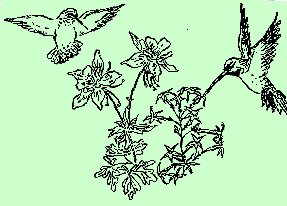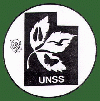|







|
. |
A Trip Eastward

 In mid-May of this year, I took three weeks to visit friends and relatives
in Colorado, Kansas, Oklahoma and Arkansas. I drove my Toyota 4-Runner,
and had the company of Melinda Harper as far as Wichita. The drive from
Salt Lake to Greeley was familiar and beautiful territory. I especially
love the drive from Grand Junction to Denver over the Rocky Mountain Divide.
The surprises that I encountered farther east, however, were especially
delightful.
In mid-May of this year, I took three weeks to visit friends and relatives
in Colorado, Kansas, Oklahoma and Arkansas. I drove my Toyota 4-Runner,
and had the company of Melinda Harper as far as Wichita. The drive from
Salt Lake to Greeley was familiar and beautiful territory. I especially
love the drive from Grand Junction to Denver over the Rocky Mountain Divide.
The surprises that I encountered farther east, however, were especially
delightful.

 When I reached my brother Bob's place in Holiday Island, Arkansas (northeast
corner), I discovered that the entire community is on the top of the Ozark
Mountains above Eureka Springs. His back deck hangs over the edge of the
ravine, and you can see for miles across the blue Ozarks. He has many bird
feeders mounted across the deck, and we were buzzed by hummingbirds, and
could watch finches and jays feed on the different seed offerings. They
had to work their way around several greedy squirrels that Bob's wife,
Marion, often threw water on to discourage them. We took a drive through
the area and saw many deer that seemed to think they owned everyon's yards.
That evening as we stood on Bob's deck, a huge black bird drifted literally
from below our feet, out of the canyon, into the air above us. Bob said
that vultures were everywhere, and I watched many of them lazily sailing
around the tree tops. I also saw them the next day as I drove west back
into Oklahoma.
When I reached my brother Bob's place in Holiday Island, Arkansas (northeast
corner), I discovered that the entire community is on the top of the Ozark
Mountains above Eureka Springs. His back deck hangs over the edge of the
ravine, and you can see for miles across the blue Ozarks. He has many bird
feeders mounted across the deck, and we were buzzed by hummingbirds, and
could watch finches and jays feed on the different seed offerings. They
had to work their way around several greedy squirrels that Bob's wife,
Marion, often threw water on to discourage them. We took a drive through
the area and saw many deer that seemed to think they owned everyon's yards.
That evening as we stood on Bob's deck, a huge black bird drifted literally
from below our feet, out of the canyon, into the air above us. Bob said
that vultures were everywhere, and I watched many of them lazily sailing
around the tree tops. I also saw them the next day as I drove west back
into Oklahoma.

 The next bird I became aware of swooped across the highway and into a deep
stand of trees. Its long tail reminded me of some exotic tropical bird,
even though its color was gray and white and black. It was a scissor-tailed
flycatcher. Its body is robin-sized. Its tail is as long as my forearm.
There are other common flycatchers in Kansas and Oklahoma, but these
scissor-tailed birds in northeastern Oklahoma are a real treat to watch.
The highways, unfortunately, were frequented by many armadillos and small
turtles that did not survive the traffic.
The next bird I became aware of swooped across the highway and into a deep
stand of trees. Its long tail reminded me of some exotic tropical bird,
even though its color was gray and white and black. It was a scissor-tailed
flycatcher. Its body is robin-sized. Its tail is as long as my forearm.
There are other common flycatchers in Kansas and Oklahoma, but these
scissor-tailed birds in northeastern Oklahoma are a real treat to watch.
The highways, unfortunately, were frequented by many armadillos and small
turtles that did not survive the traffic.

 I had a long stay at my friend Willa's in Seminole, Oklahoma, just southwest
of Oklahoma City. This gave me more time to observe nature, as she lives in
a semi-forested area surrounded by pastures, ponds, and cattle. The ponds
teemed with bullfrogs and other water critters, and beautiful egrets. The
trees had many dead snags which had become homes to the huge pileated
woodpeckers. Willa had a hummingbird feeder hanging in the tree by her
trailer, and we found that the giant black ants found it too inviting. We
spent many hours trying to devise a way to discourage them. I hung up an
aluminum pie plate upside down over it, with vaseline covering the top side,
and greased the cord holding the feeder as well, but it was only semi-successful.
On my last day in Oklahoma, we visited Willa's sister, Shirley, in Norman.
They have a home in a beautiful wooded area a short distance from a huge
man-made lake. That evening we were visited by many deer, which are fed
daily by Shirley and her husband, Don. The birds that came to feed and play
in their bird bath included: huge black crows (not ravens), cardinals, blue
jays, and the breathtakingly beautiful painted buntings.
I had a long stay at my friend Willa's in Seminole, Oklahoma, just southwest
of Oklahoma City. This gave me more time to observe nature, as she lives in
a semi-forested area surrounded by pastures, ponds, and cattle. The ponds
teemed with bullfrogs and other water critters, and beautiful egrets. The
trees had many dead snags which had become homes to the huge pileated
woodpeckers. Willa had a hummingbird feeder hanging in the tree by her
trailer, and we found that the giant black ants found it too inviting. We
spent many hours trying to devise a way to discourage them. I hung up an
aluminum pie plate upside down over it, with vaseline covering the top side,
and greased the cord holding the feeder as well, but it was only semi-successful.
On my last day in Oklahoma, we visited Willa's sister, Shirley, in Norman.
They have a home in a beautiful wooded area a short distance from a huge
man-made lake. That evening we were visited by many deer, which are fed
daily by Shirley and her husband, Don. The birds that came to feed and play
in their bird bath included: huge black crows (not ravens), cardinals, blue
jays, and the breathtakingly beautiful painted buntings.
 On my return home I received the following message from Willa:
On my return home I received the following message from Willa:
"Had a real eye-opening experience this last week. The male
hummingbird was throwing a fit out by the feeder. There was a female on
the feeder and she was crying. I went out to see what was going on. Her
tongue was stuck in one of the yellow "flowers". I ended up holding her and
pulling the flower off of the body of the feeder. It looked like the end
of her tongue was swollen and engorged with blood. She was still crying
and the male was hovering, but not trying to dive-bomb me. I called the
vet for directions. I got nothing but, "No one here knows anything about
hummingbirds, but bring it in and we will see if there is anything we can
do." Sure, like I could walk down there holding onto a screaming bird.

 I called Ralph, a neighbor, and he was there in three minutes. He hopped
out of his pickup and picked up the scared bird. Mr. Hummingbird was still
hovering and giving advice and consolation to his lady. You have never
heard anything so heart-wrenching as the cry she was making -- poor little
one. Ralph got hold of the swollen portion of the tongue and pulled on it
gently to see how we could drain it, but it wasn't her tongue at all. It
was the head of one of those large black ants. It had grabbed the lady's
tongue with its pincers and braced its feet on the inside of the flower,
and was either stubborn or unable to release its grip. Ralph was able to
kill the ant without hurting the bird's tongue. Poor baby, it couldn't get
its tongue back into its beak, probably because it had been extended so far
for such a long time. The tongue finally began to retract, and we got it
to drink some of the nectar from the feeder. It finally took off and went
home with Mr. Hummingbird flying escort. I found out how to ant-proof the
feeder. I hung the feeder on a very thin piece of wire and dropped the
feeder down lower, below the leaves of the tree, and greased the wire with
butter."
I called Ralph, a neighbor, and he was there in three minutes. He hopped
out of his pickup and picked up the scared bird. Mr. Hummingbird was still
hovering and giving advice and consolation to his lady. You have never
heard anything so heart-wrenching as the cry she was making -- poor little
one. Ralph got hold of the swollen portion of the tongue and pulled on it
gently to see how we could drain it, but it wasn't her tongue at all. It
was the head of one of those large black ants. It had grabbed the lady's
tongue with its pincers and braced its feet on the inside of the flower,
and was either stubborn or unable to release its grip. Ralph was able to
kill the ant without hurting the bird's tongue. Poor baby, it couldn't get
its tongue back into its beak, probably because it had been extended so far
for such a long time. The tongue finally began to retract, and we got it
to drink some of the nectar from the feeder. It finally took off and went
home with Mr. Hummingbird flying escort. I found out how to ant-proof the
feeder. I hung the feeder on a very thin piece of wire and dropped the
feeder down lower, below the leaves of the tree, and greased the wire with
butter."
Isn't it amazing the things nature provides us to worry about?

-- by Jean White
|
|

